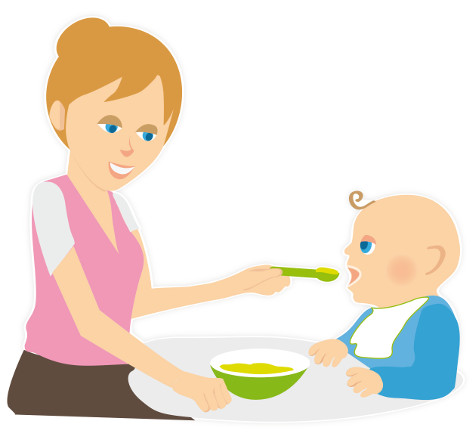
Are you the kind of parent who is the high control freak? You will decide when and how much your child eats, the force feeder, the stick is not far away during meal time. Are you the type who leaves the child to feed themselves. The parent who believes that the child will eat if hungry and he or she stops eating, it means they have had enough to eat even if very little food was consumed. Or are you the type of feeder who feeds in response to the child’s cues or signals using encouragement and praise?
Responsive care refers to the behaviors and practices of the parents and family that provide the stimulation and emotional support as well as food and health care necessary for the child’s healthy growth and development. Infants are dependent on a caregiver to provide all their food. With age, the infant gradually develops the skills for relatively independent in eating as a young child such as picking up pieces of food and moving it to the mouth, choosing foods, and using feeding utensils. Similar to many other skills that the young child develops, responsive care practices related to eating can help, or hinder, the development of these skills and behaviors. While feeding a child, they might show they are ready for another bite by opening their mouth, leaning forward, or gazing at you. It is important to note that the pace of feeding should be driven by the child and not the feeder.
Responsive feeding is the reciprocal relationship that involves:
- The child giving cues or signs or signals for hunger or fullness;
- The parent noticing the child’s cues, the accurate interpretation of that sign, and responding to the sign in an appropriate way;
- The child perceiving there is a response to his/her cue and that this response is predictable.
Non-responsive feeding may include a parent controlling the feeding and deciding when and how much is eaten, or a parent ignoring the child’s cues and limited interaction. Both types of non-responsive feeding can result in stressful mealtimes and overall family relationship difficulty.

Another form of non-responsive parenting may occur when child cues are misinterpreted and food is seen as the solution. Have you seen mothers who say, the breast is the solution to every cry for the baby. Once the child begins to cry, without even thinking about it, the latch them onto the breast. This parent thinks the infant is not getting enough breast milk because the infant is crying soon after a feed. Some will give a tired toddler in the late afternoon who wants a cuddle and a rest some sweet biscuits and tell them to go off and play until it is family dinner time. Infants or young children need assistance that is appropriate to their age and development needs to support adequate nutrition.
Non-responsive feeding practices where the parent controls the feeding may result in overeating if, for example, children learn to eat when they are not hungry or that they should always continue eating until the bowl is empty. Eating until the bowl is empty at every meal may be beyond satiety and may be over-fullness. Finishing all the food in the bowl at every meal may mean that the parent does not respond to the child’s signs that he/she has had enough to eat. The baby or child learns to ignore the inborn mechanism for satiety and a new level is set where eating to over-fullness becomes the expected feeling. This exposes the child to over eating and may gain weight rapidly there by increasing the risk of lifelong obesity.
Steps to Responsive Feeding
- Pay attention to the infant’s or child’s communication
- Respond warmly and promptly
- Feed the right food for the infant’s or child’s age and stage
- Let the infant or child stop when they are full
- Focus on being affectionate and nurturing
Benefits of Responsive Feeding
- Responsive feeding helps to keep your levels of breast milk high and consistent, which naturally decreases any chances of painful feedings or blocked ducts. Oddly enough, the more milk your baby eats, the more milk you will produce—it’s part of the beautiful circle of life.
- Babies who are fed using responsive feeding establish much better eating habits that carry into adulthood. When a strict schedule is implemented, babies are often fed past the point of fullness, which carries into toddler, teen, and adult eating habits which are using detrimental to their health.
- I cannot begin to exhaust the bond that is created between you and the child. Unknown to you, mealtimes are an important learning environment where socialisation and language development takes place the most.
In conclusion responsive feeding only means that the parent observes, interprets accurately and responds appropriately to the signs or signals that the baby or young child gives. It is time to uncover the baby’s face as you feed them, pay extra attention to your toddler as they feed and enjoy the benefits of responsive feeding.

fabulous post
Thank you so much